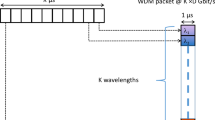Abstract
In this paper, we present the basic idea and some concepts for the architecture of the ATM switching system being developed in ETRI of KOREA, and also describe its performance. RSE (Reference Service Entity) concept is introduced to define the characteristics of user’s traffic. This concept is useful to represent the demand of CPE (Customer Premise Equipment) user sets and one of point‐to‐multipoint connections. We also propose RUCA (Reference Units for Connection Attempts) concept with which we can illustrate the call/connection level performance of the ATM switching system. This concept can be applied for measuring the call processing capability in both point‐to‐multipoint connections and multipoint‐to‐multipoint connections when call set‐up between users is performed by a sequence of point‐to‐point connections basis. From the basic concepts and the recommendations of ITU‐T, the design objective of the system performance is specified. We represent the methodologies for dimensioning the system to achieve the design objectives, and estimate the system performances. Then we show that our developing system has suitable performance to accommodate the future B‐ISDN.
Similar content being viewed by others
References
D. Becker, Prospective views on the alcatel broadband architecture, Electrical Communication 64(2/3) (1990) 147–155.
L. Bermejo et al., Service characteristics and traffic models in a broadband ISDN, Electrical Communication 64(2/3) (1990) 132–138.
C. Blondia, A discrete time Markovian arrival process, RACE 1022 Document PRLB 123 0015 CD CC (1989).
E. Brockmeyer et al., The Life and Works of A.K. Erlang (The Copenhagen Telephone Co., 1948).
E. Cinlar, Superposition of point process, in: Stochastic Point Processes: Statistical Analysis, Theory and Application, ed. P.A.W. Lewis (Wiley, New York, 1972) pp. 549–606.
R.B. Cooper, Introduction to Queueing Theory, 2nd ed. (North-Holland, Amsterdam, 1981).
L.G. Dron, G. Ramamurthi and B. Senguota, Delay analysis of continuous bit rate traffic, in: ITC 13, Vol. 15: Queueing, Performance and Control in ATM (Copenhagen, 1991) pp. 33–38.
W. Fisher, A scalable ATM switching system architecture, IEEE Journal on Selected Areas in Communications 9(8) (1991) 1299–1307.
G. Galassi et al., Resource management and dimensioning in ATM networks, IEEE Network Magazine (May 1990) 8–17.
D. Gross and C.M. Harris, Fundamentals of Queueing Theory (Wiley, New York, 1985).
H. Heffes and D.M. Lucantoni, A Markov modulated characterization of packetized voice and data traffic and related statistical multiplexer performance, IEEE Journal on Selected Areas in Communications 4(6) (1986) 856–867.
J.Y. Hui, Switching and Traffic Theory for Integrated Broadband Networks (Kluwer, Dordrecht, 1991).
ITU-T Recommendations, E.716, E.73x, E.73y, E.73z.
ITU-T Recommendations, I.371, I.35bcp, I.356.
ITU-T Recommendation, Q.543.
J.S. Kaufman, Blocking in a shared resource environment, IEEE Transactions on Communications 29(10) (1981) 1474–1481.
F. Kelly, Reversibility and Stochastic Networks (Wiley, New York, 1979).
Y.B. Kim, S.S. Lee et al., An architecture of scalable ATM switching system and its call processing capacity estimation, ETRI Journal 18(3) (1996) 107–125.
P.J. Kuehn, Reminder on queueing theory for ATM networks, Telecommunication Systems 5 (1996) 1–24.
H. Lee et al., A shared output buffer switch for ATM, in: Proc. of the 4th Internat. Conf. on Data Communication Systems and Their Performance, Barcelona (1990) pp. 163–179.
J.A Morrison, Blocking probabilities for multiple class batched Poisson arrivals to a shared resource, Performance Evaluation 25 (1996) 131–150.
R.O. Onvural, Asynchronous Transfer Mode Networks: Performance Issues (Artech House, 1994).
G.-M. Park, S.-Y. Kang and C.-M. Han, Performance evaluation of a cell reassembly mechanism with individual buffering in an ATM switching system, ETRI Journal 17(1) (1995).
J. Roberts, A service system with heterogeneous user requirements, in: Performance of Data Communications Systems and Their Applications, ed. G. Pujolle (North-Holland, Amsterdam, 1981) pp. 423–431.
K.W. Ross, Multiservice Loss Models for Broadband Telecommunication Networks (Springer, Berlin, 1995).
H. Saito, Teletraffic Technologies in ATM Networks (Artech House, 1994).
K. Sriram and W. Whitt, Characterizing superposition arrival processes in packet multiplexers for voice and data, IEEE Journal on Selected Areas in Communications 4(6) (1986) 833–846.
K. Suzuki, An ATM switching system – development and evaluation, NEC Research and Development 32(2) (1991) 242–250.
H. Takagi, Queueing Analysis: A Foundation of Performance Evaluation, Vol. 3: Discrete-Time Systems (North-Holland, Amsterdam, 1993).
E.W. Zegura, Architectures for ATM switching systems, IEEE Communication Magazine (February 1993) 28–37.
Author information
Authors and Affiliations
Rights and permissions
About this article
Cite this article
Lee, S.S., Lee, J.G., Oh, C.H. et al. An architecture of scalable ATM switching system and its performance. Telecommunication Systems 14, 269–290 (2000). https://doi.org/10.1023/A:1019101819481
Issue Date:
DOI: https://doi.org/10.1023/A:1019101819481




